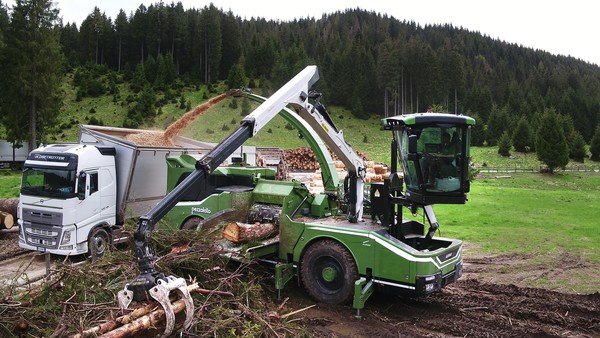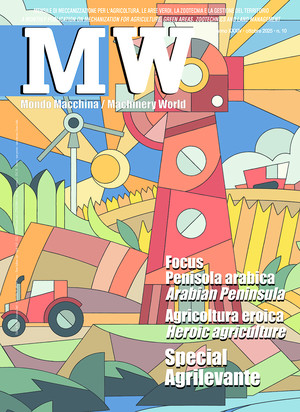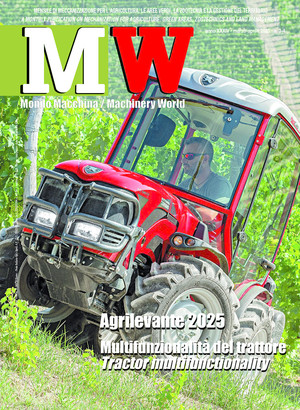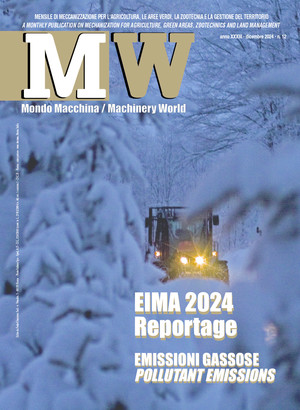
Biomass and bioenergy: the new agro-industry frontier
FederUnacoma and ITABIA experts have organized a seminar on the opportunities offered by the use of biomass energy. Bioenergy is in full development but further growth will require
Providing an overview of the biomass and bioenergy sector, the opportunities offered by this sector and the technical, administrative and management issues related to it is the objective of the seminar entitled “Biomass and Bioenergy: the new agro-industry frontier” organized by ITABIA (the Italian Biomass Association), as part of the training initiatives promoted by FederUnacoma with AFI Accademia. The seminar, conducted by Vito Pignatelli and Raffaele Spinelli, President and Council Member of ITABIA, respectively, reiterated the importance of agricultural and forestry biomass as a renewable resource with multiple applications in the industrial and energy sectors. Given the great availability in Italy, proper development – as was specified by Pignatelli and Spinelli – can generate enormous benefits to the environment, communities and economies of Italian territories. However, the development of biomass requires the creation of local production chains utilizing a systemic approach in which the technological and innovative components play a primary role for the success of the initiatives undertaken. Precisely for this reason, biomass – the raw material for the circular bioeconomy and bioenergy sector – is fully included in the main development strategies outlined at the European (Green Deal and Next Generation) and national (PNIEC and PNRR) level, for which Pignatelli has provided a detailed reference framework.
Renewables, the European objectives. "The European Green Deal – said Pignatelli – has been created due to the need to combat climate change and environmental degradation which today constitute an enormous threat for Europe and the world. To overcome these challenges, on December 11, 2019 the European Commission adopted a strategy that will transform the EU into a modern, resource-efficient and competitive economy, also in light of the commitment to net zero greenhouse gas emissions by 2050". From climate to energy, and transport to taxation, in the short term – the president of ITABIA explained – the EU will have to adopt policies aimed at reducing net greenhouse gas emissions by at least 55% compared to 1990 levels by 2030 (Fit For 55). Furthermore, as established by EU Regulation 1999/2018 (December 11, 2018), Member States must prepare and periodically update a National Integrated Plan for Energy and Climate (PNIEC) indicating strategies, interventions and tools to achieve the European energy and climate policy objectives. In particular, the Italian PNIEC plans to cover 39.4% of gross final energy consumption needs from renewable sources (63.4% for electricity consumption) by 2030, an amount of energy from RES equal to 34.2% (of which 11.6% from biofuels and advanced biogas) in gross final energy consumption in the transport sector, a reduction of at least 66% of greenhouse gas emissions divided among the ETS sectors (energy industries, energy-intensive industrial sectors and aviation) and non-ETS sectors (transport, residential, tertiary, non-ETS industry, agriculture and waste). In Italy – it was explained during the seminar – in 2023 (latest consolidated data) the gross final consumption (CLF) of energy produced by the various renewable sources amounted to a total of 22.6 MToe (Millions of tons of oil equivalent) out of a total consumption of 115.4 Mtoe. This means that RES provided just under 20% of the national energy requirement. Among all RES, bioenergy covered, again in 2023, 8.2% of energy consumption (9.5 MToe), or half of all green energy produced.
To meet the PNIEC targets, despite the reduction in consumption linked to energy efficiency (32% in construction and transport), it will be necessary to double production from renewable sources with a strong increase in bioenergy which, as is known, is able to operate on multiple fronts (electricity, heat and transport). "In this perspective, to make biomass usable it becomes essential to take it from the fields and forests, condition it, transport it and store it. Modern mechanization – Raffaele Spinelli argued – is therefore essential to ensure production levels adequate to the demands of a continuously expanding market, both from a quantitative and qualitative point of view".
Biomass and forest management on display at FUTA Expo. For this reason, ITABIA, in collaboration with FederUnacoma, has created the FUTA Expo event, during which it will be possible to witness field demonstrations of vehicles and equipment for cutting and handling forest biomass. During the seminar Raffaele Spinelli provided a detailed description of the main machinery and technological systems used for forestry operations and which will be presented at the ITABIA event scheduled to be held in Barberino di Mugello from July 4th to 6th. A wide range of equipment and machinery is available on the market today – explained Spinelli – designed by manufacturers specifically to optimize forestry operations, while increasing operator safety. Of particular interest is the advanced mechanization, by virtue of which the entire process of harvesting material is performed with the aid of mechanical means, with the operator having "no foot on the ground, no hand on the wood", according to the motto of New Zealand experts in the field of workplace safety. "Advanced mechanization – said Spinelli – can be achieved with two different working systems: shortwood or whole tree". With the shortwood system, the tree is felled, de-limbed and de-hewn with a harvester and the logs are cleared with a forwarder. In the second system, however, the tree is felled with a feller (or feller-buncher, if in addition to felling the tree the vehicle forms neat piles of several trees) and is removed by trawling with a skidder, to then be de-limbed and chopped up (or chipped whole) in the roadside processing yard.
Cableways. Many Italian forests located on steep terrain are difficult to reach by forestry tractors without the use of special roads. However, these infrastructures are very expensive to build, both economically and environmentally, as well as requiring complicated permit procedures. The ideal solution is offered by aerial logging with a cableway. Widespread in the Alps (over 350 pieces of equipment) and growing in the Apennines (over 50 units), the cableway is an efficient and ecological solution, because it causes minimal environmental impact even on the most difficult terrain. At the FUTA Expo, 5 cable logging lines will be set up to demonstrate the possibilities of using this equipment in all working conditions, uphill, downhill and even on flat ground.
Brush cutters. These are indispensable for work intended to protect the territory and aimed, for example, at reducing vegetation on road embankments and under telephone and electricity lines, or at opening up fire zones capable of allowing effective prevention and control of fire.
Chippers and shredders. These permit the wood taken from the forests (logs, branches and tops) to be transformed into small flakes of uniform size (“chips”) to be used as renewable biofuel for energy conversion plants (heat and electricity). Nowadays, wood chippers come in a wide variety of models and configurations: tractor-driven, trailer-mounted, with independent engine, or mounted on a truck (with or without independent engine) or self-propelled. All these types of machinery will be presented at FUTA Expo, starting from light models applied to a common farm tractor and designed for the production of wood chips, up to the most massive and technological designs, completely self-propelled and capable of driving both on the road and off-road.
Firewood processing: Firewood is a huge market experiencing enormous growth, both in Italy and abroad. In Italy alone, the estimated annual consumption exceeds 10 million tons, with an extremely important economic return for the internal areas of the country, where it is a great source of employment and a significant way to boost incomes. The production of firewood requires a series of processes, including chopping and splitting, which are necessary to reduce the log to a size more suitable for use in stoves, ovens or fireplaces. These operations are carried out with a cutting machine and a splitting machine (log splitter), respectively, often built into a single machine: the firewood processing center. At FUTA Expo, numerous machine types will be in operation: from the disc cutting machine to the most modern, fully automated and optimized processing centers, in terms of processing efficiency (measurement precision, absence of waste), processing speed and energy efficiency.
Equipment for farm tractors. In Italy, the farm tractor is still the vehicle most widely used for clearing and moving timber. Research carried out by the CNR in 2013 and again in 2024 suggests that for every specialized forestry tractor (skidder or forwarder), there are at least 25 farm tractors set up for forestry use. Although less specialized and agile than a special forestry vehicle, the farm tractor has the advantage of being more versatile and enjoying an extremely widespread assistance and maintenance network. To operate effectively in forestry, the farm tractor must be adequately accessorized (guards, special tires, etc.) and coupled with a forestry tool suited to the task to be performed: winch, trailer or crane – or perhaps even a firewood bundler.
Stump removal: Another exclusive offering at FUTA Expo will be live stump removal demonstrations, which, due to the difficulty of finding a suitable site for the purpose, have almost never been put on for such a large audience at a demonstration event. Preparation for these live demos required converting an old conifer reforestation that had not been well maintained back into a meadow, successfully starting the complex authorization procedure.
Thus, just a few dozen meters away from the expo center, demonstrations of two different types of stump cutters: the shear-remover and the drill, will be held for the public. The first will be applied to a powerful hydraulic excavator and will uproot the stumps and then cut them into small pieces and pile them up in the field for removal, while the second – applied to a lighter excavator – will crush the stumps directly on site. Finally, a third option for partial stump removal will also be demonstrated, making use of a heavy forestry mulcher.








